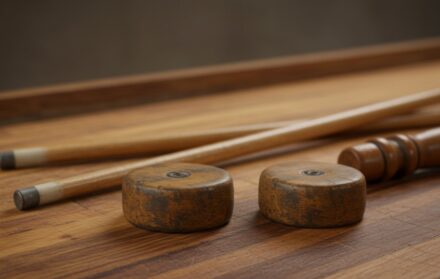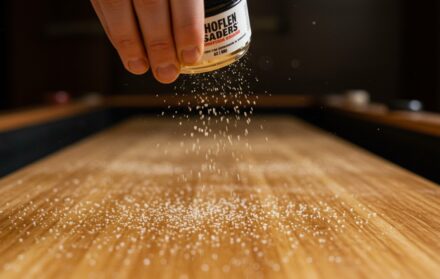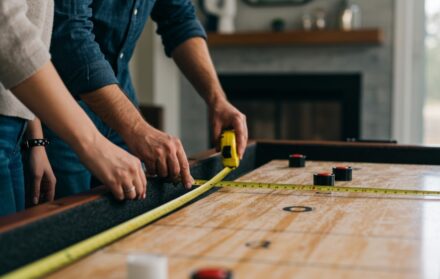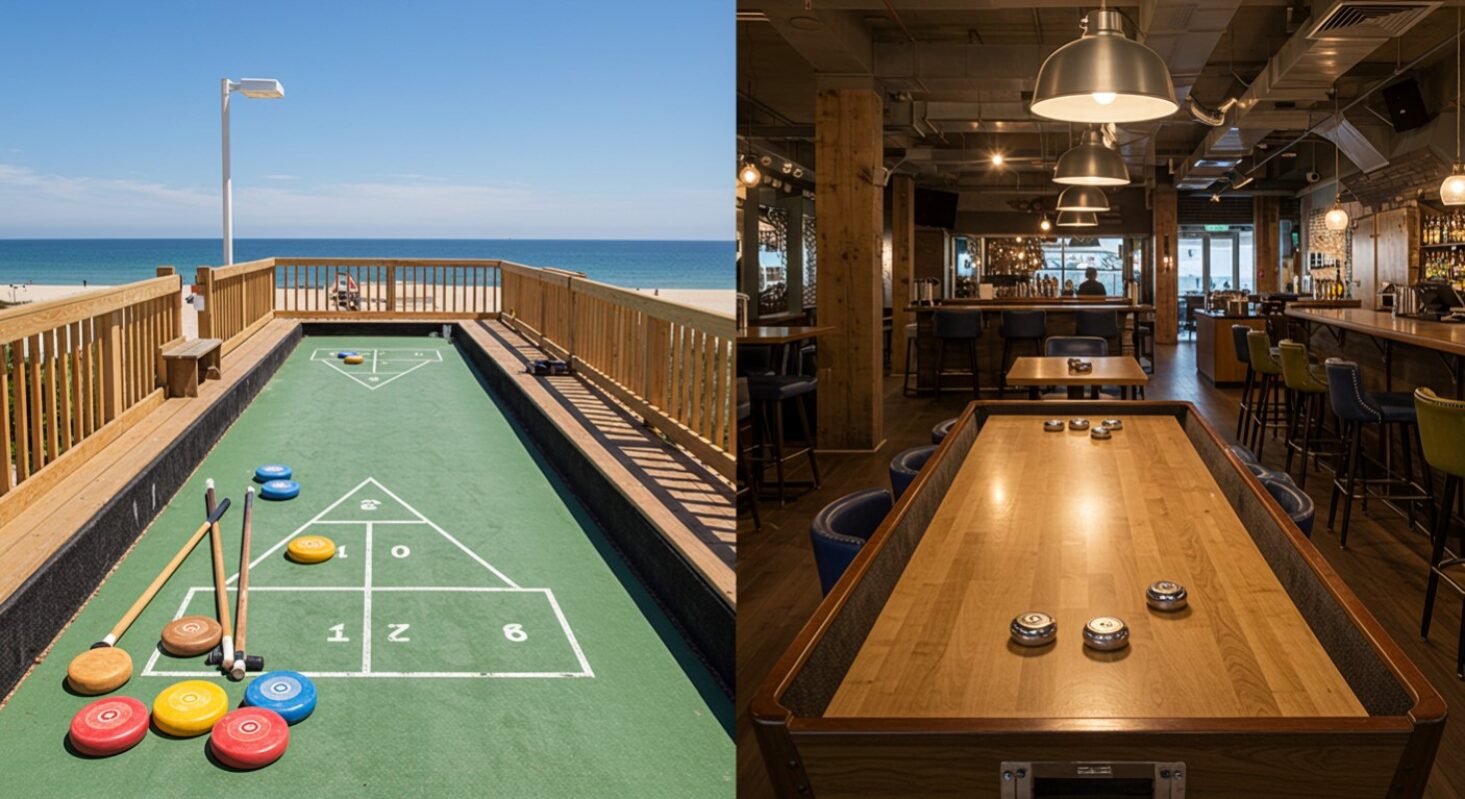
What’s the Difference Between Deck Shuffleboard and Table Shuffleboard?
Shuffleboard is one of those curious games that manages to be both simple and endlessly adaptable. If you walk into a modern London pub, you might find a long polished table with players carefully sliding weighted pucks towards scoring zones at the far end. Step onto the deck of a cruise ship, however, and you could witness another version altogether, where discs the size of dinner plates are being pushed across painted courts with long sticks called cues.
Both versions share the same name — shuffleboard — and both revolve around the same principle: sliding objects towards scoring areas to outscore your opponent. Yet, in practice, deck shuffleboard and table shuffleboard feel like very different experiences. The surfaces are different, the equipment is different, the scoring is different, and even the social settings where you play them are worlds apart.
In this article, we will explore the differences between deck shuffleboard and table shuffleboard in detail. We will trace their origins, look at the rules and equipment that define them, compare their styles of play, and explain where you are most likely to encounter each version today. By the end, you will have a clear understanding of how these two branches of shuffleboard evolved and why both continue to attract loyal players across the world.
Shared Origins
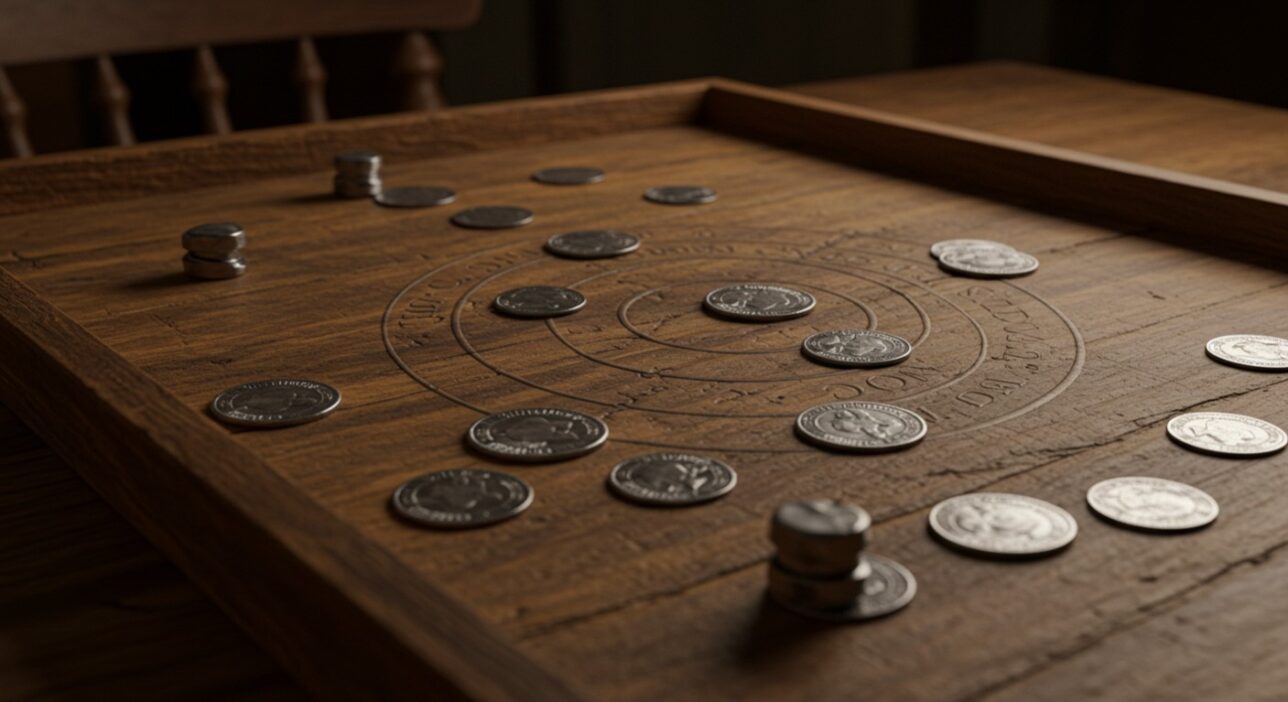
To understand the difference between deck shuffleboard and table shuffleboard, it helps to know that they are both offshoots of the same historical pastime. The game can be traced back to 15th-century England, where a coin-sliding game known as shove-groat became popular in taverns. Players would shove large coins along a table, trying to land them in marked sections or push them closest to the edge without falling off.
Over time, shove-groat evolved into games played with discs or pucks instead of coins. This form became known as shovel board or shuffleboard, and it spread through English pubs and even into the royal court. King Henry VIII was known to enjoy the game, although he banned his servants from playing it due to concerns about gambling and wasted time.
As England expanded overseas, shuffleboard crossed the Atlantic. It became a tavern pastime in the American colonies and developed in two distinct directions. One branch led to the long, narrow shuffleboard tables we now associate with pubs and bars. The other gave rise to deck shuffleboard, adapted for ship passengers who needed entertainment on long ocean voyages.
Playing Surfaces
The first major difference between deck shuffleboard and table shuffleboard lies in their playing surfaces.
Table Shuffleboard
Table shuffleboard is played on a long, narrow, polished wooden table. The standard tournament length is 22 feet, though home and pub versions are often shorter, ranging from 9 to 16 feet. The surface is finished with a smooth lacquer and topped with shuffleboard wax (tiny silicone beads or sand) to reduce friction.
At the far end of the table are the scoring zones, typically divided into three bands worth 1, 2, and 3 points, with the farthest edge sometimes offering a 4-point “hanger” if a puck overhangs without falling.
Because the table surface is elevated and smooth, the game feels fast-paced and precise. Every tiny push can send a puck sliding far down the table, so control and touch are vital.
Deck Shuffleboard
Deck shuffleboard, by contrast, is played on a large flat court, usually outdoors or on a ship’s deck. A standard deck court measures 52 feet long and 6 feet wide, with triangular scoring zones painted at each end. The triangles are divided into scoring areas worth 10, 8, and 7 points, with a “10 off” section at the base that deducts points if a disc lands there.
Instead of standing at a table, players push large discs along the floor using long cues. The feel of the game is more leisurely, with discs gliding at slower speeds over a much longer surface. Strategy still matters, but there is more emphasis on blocking opponents and avoiding penalties than on delicate fingertip control.
Equipment
The equipment used in each version of shuffleboard further highlights their differences.
Table Shuffleboard Equipment
-
Pucks (weights): Small, heavy metal discs about 2 inches in diameter, usually capped in plastic. Each player or team has four pucks, traditionally coloured red and blue.
-
Table: Wooden, narrow, and highly polished.
-
Shuffleboard wax (sand or beads): Sprinkled on the table to allow pucks to glide smoothly. Without wax, the pucks would barely move.
Deck Shuffleboard Equipment
-
Discs: Much larger than table pucks, typically 6 inches across, and made from durable plastic or wood. They are light enough to slide but heavy enough to hold their path.
-
Cues: Long sticks, usually 6–7 feet, with a forked end to push the discs.
-
Court: A painted surface, usually concrete or ship decking, marked with scoring triangles.
The difference in equipment contributes to the distinct feel of each game. Table shuffleboard is played with your hands, relying on precision finger flicks. Deck shuffleboard uses cues, requiring broader strokes and more physical involvement.
Rules and Scoring
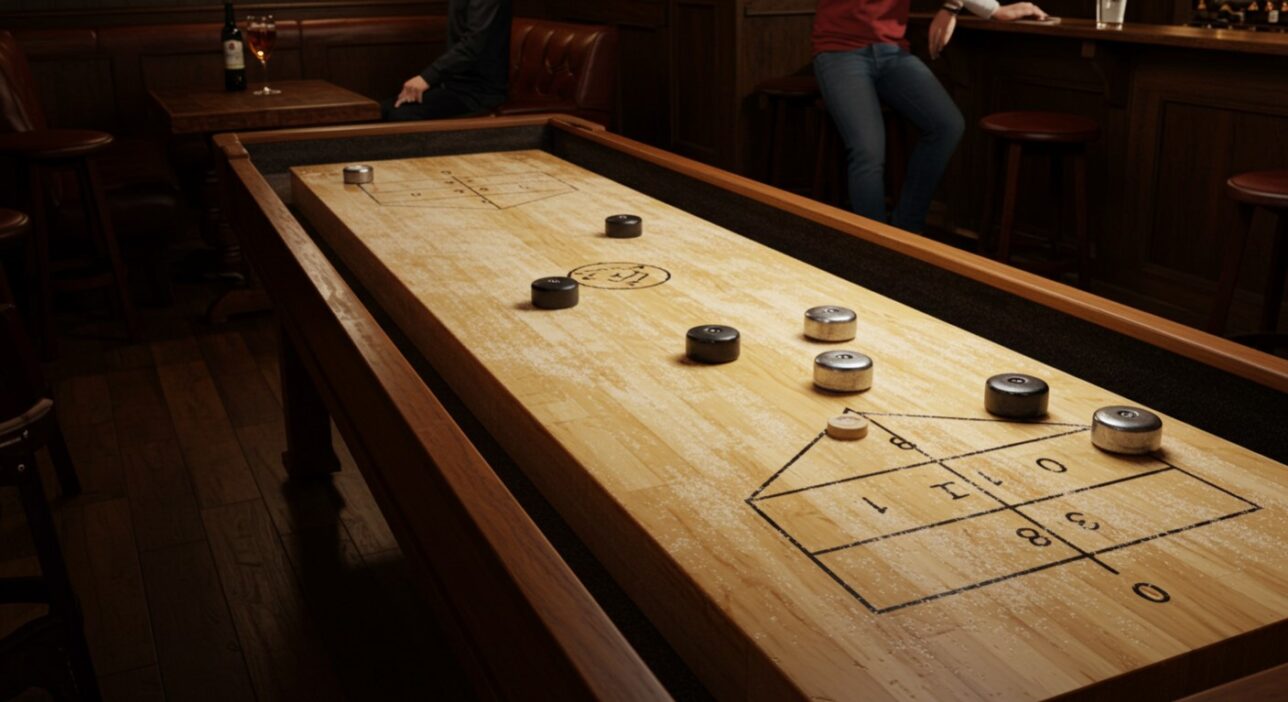
While both games revolve around sliding objects into scoring zones, the details differ considerably.
Table Shuffleboard Rules
-
Each player slides their four pucks alternately down the table.
-
Pucks must be slid from behind the foul line.
-
Scoring zones are marked 1, 2, and 3.
-
To score, a puck must be entirely past the scoring line.
-
A “hanger” (a puck hanging partly over the edge) is usually worth 4 points.
-
Only the player with the leading puck scores in each round, counting all of their pucks that are ahead of the opponent’s best.
-
Games are often played to 15 or 21 points, though tournament formats can vary.
Deck Shuffleboard Rules
-
Each player pushes their discs alternately using a cue.
-
Discs must cross the baseline to count.
-
The triangular scoring zones award 7, 8, or 10 points.
-
Discs landing in the “10 off” area subtract 10 points from that player’s score.
-
Games are usually played to 75 points or for a set number of rounds (commonly 8 or 10).
Both versions allow — and encourage — knocking opponents’ pieces out of scoring positions. However, the way points are calculated makes deck shuffleboard a higher-scoring, longer game compared with the short, sharp contests of table shuffleboard.
Playing Style and Strategy
Because of these differences in rules and surfaces, the styles of play diverge significantly.
-
Table shuffleboard is all about precision. The key is to judge speed and angle so that your puck stops in the right scoring zone without sliding off the end. Strategy often involves blocking opponents’ paths or knocking their pucks off while protecting your own. Games are relatively quick, making table shuffleboard a lively pub activity.
-
Deck shuffleboard is slower and more methodical. The longer court means discs take time to reach the scoring area, and players must think several moves ahead. Because the scoring system includes penalties, accuracy matters as much as bold attacking shots. The use of cues also makes it a more physical game, requiring balance and smooth strokes rather than finger control.
Social and Cultural Settings
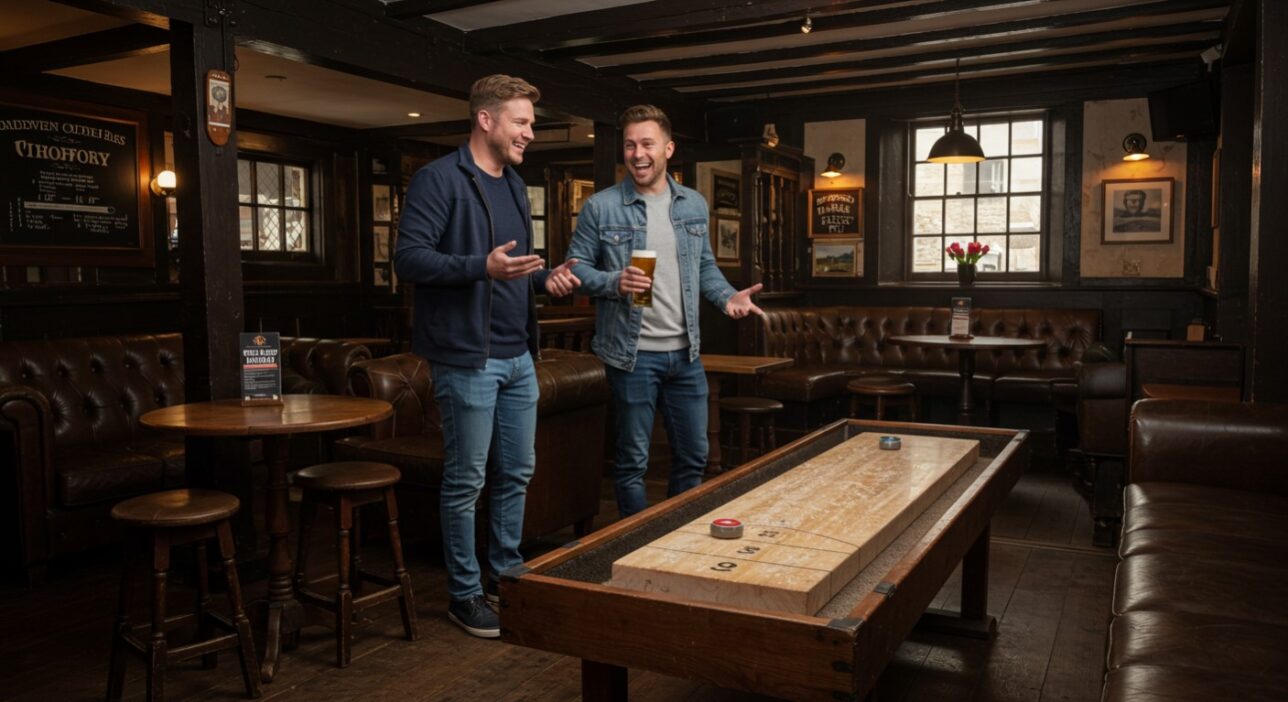
One of the most striking differences between deck shuffleboard and table shuffleboard is where they are played and the culture surrounding them.
-
Table shuffleboard has become a staple of pubs, bars, and clubs. In the United States, it thrived in bars during the mid-20th century, and today it has resurged in modern social venues. In the UK, you will find shuffleboard tables in London bars, often alongside darts and other pub games. It is a game associated with nightlife, competition, and socialising over drinks.
-
Deck shuffleboard is more closely tied to leisure travel. It became a hallmark of passenger liners in the 19th and early 20th centuries, providing entertainment on long voyages. Today it remains iconic on cruise ships, often played by holidaymakers of all ages. In North America, it is also popular in retirement communities, where outdoor courts provide a gentle, sociable activity.
So while both games share DNA, their cultural niches differ: table shuffleboard is the pub classic, while deck shuffleboard is the holiday pastime.
Side-by-Side Comparison
Here is a clear comparison of the two versions:
| Aspect | Table Shuffleboard | Deck Shuffleboard |
|---|---|---|
| Surface | Wooden table (9–22 feet). | Painted court (52 feet long, 6 feet wide). |
| Equipment | Metal pucks, waxed surface. | Large discs, long cues. |
| Scoring | 1–3 points per zone, 4 for hangers. | 7–10 points, “10 off” penalty zone. |
| Gameplay | Fast, precise, hand-controlled. | Slower, cue-driven, more deliberate. |
| Duration | Usually to 15 or 21 points. | Often to 75 points or set number of rounds. |
| Setting | Pubs, bars, indoor clubs, home games rooms. | Cruise ships, outdoor courts, leisure centres. |
| Cultural Role | Lively pub competition, bar entertainment. | Holiday activity, community recreation. |
Which Version Should You Play?
If you are curious about shuffleboard and wondering which version might suit you, the answer depends on context and preference.
-
If you enjoy competitive pub games like darts or pool, table shuffleboard is a natural fit. It is fast-paced, skill-driven, and works well in short sessions. It is also ideal if you are looking for something to play at home, provided you have the space for a table.
-
If you prefer relaxed, social games during holidays or outdoor gatherings, deck shuffleboard may be more your style. It requires less fingertip precision, is easy for beginners, and works well in community or family settings.
Both versions reward strategy, both are sociable, and both have stood the test of time. Choosing one over the other is less about which is “better” and more about where you happen to be playing.
Conclusion: Understanding the Difference Between Deck Shuffleboard and Table Shuffleboard
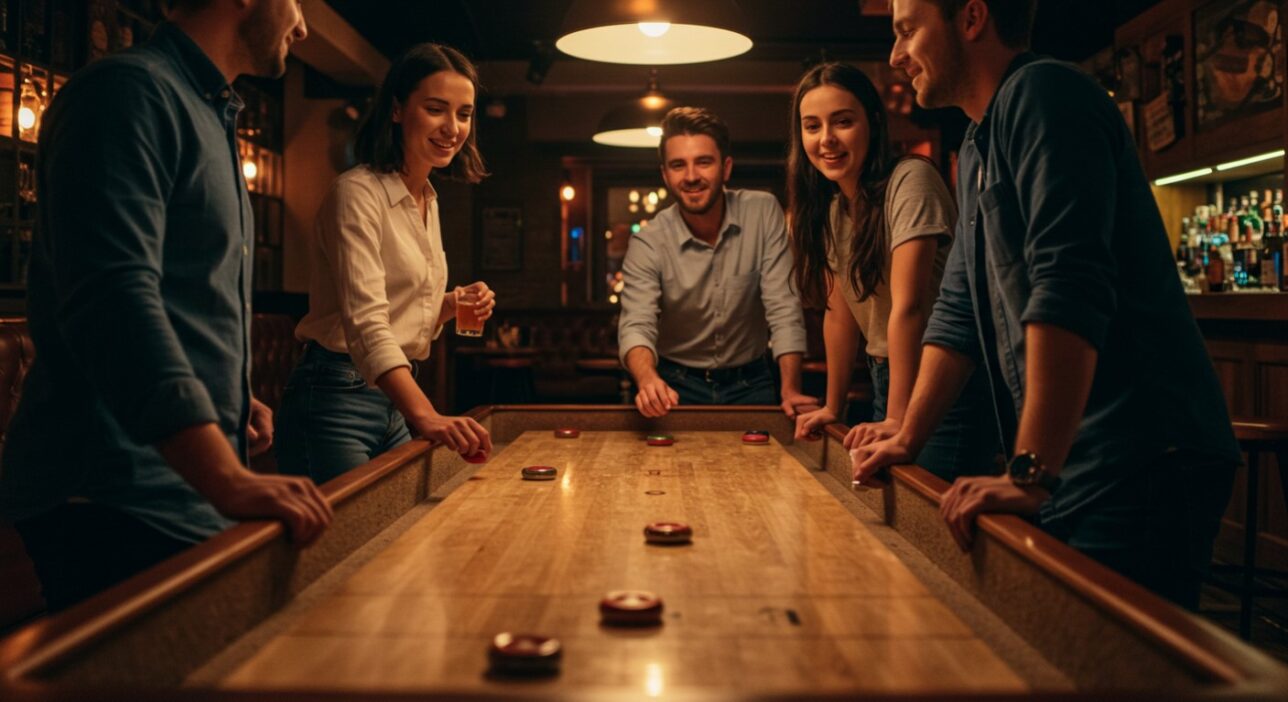
Deck shuffleboard and table shuffleboard share the same ancestry but have grown into distinct games. One is played indoors on long polished tables, using small weighted pucks and waxed surfaces. The other is played outdoors or on ship decks, with large discs, long cues, and triangle-shaped scoring zones.
The difference between deck shuffleboard and table shuffleboard lies not only in their equipment and rules but also in their cultural identities. Table shuffleboard thrives in pubs and bars as a quick, competitive game of skill. Deck shuffleboard endures as a slower, sociable pastime associated with cruises and holidays.
Both continue to attract players because they blend simplicity with strategy. Whether you prefer the fast flick of a puck across a table or the leisurely push of a disc down a deck, shuffleboard in all its forms remains a game of precision, rivalry, and above all, fun.
